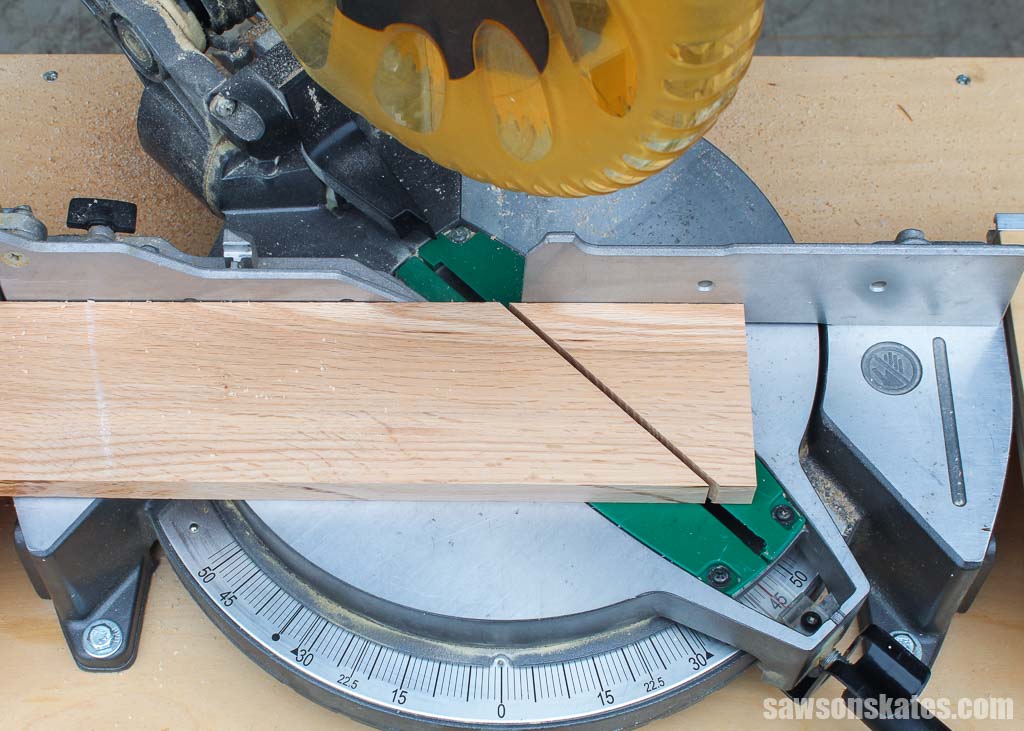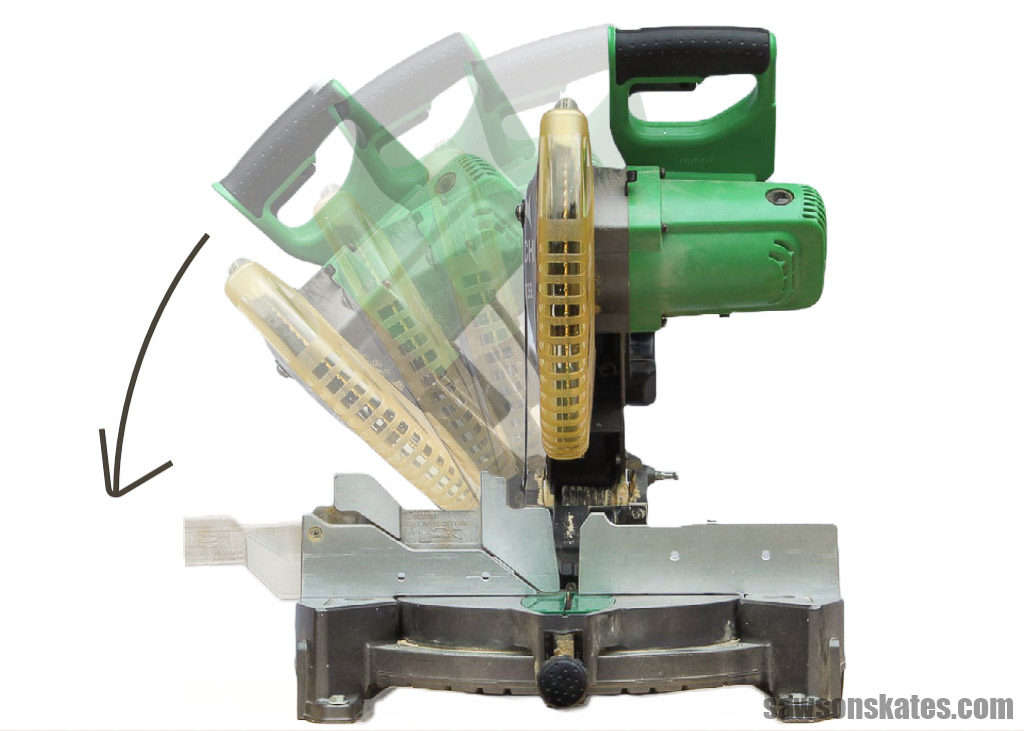Single vs Double Bevel Miter Saw (Which to Buy & Why)
Unsure if you need a single or double bevel miter saw? Wonder what the difference is? I’ll break it down and help you decide which is best for you.

Do you know the difference between a single bevel miter saw and a double bevel miter saw? If not, don’t worry! In this article, I’ll explain the differences between these two power tools, what each saw is typically used for, and the benefits and drawbacks of each. By the end, you’ll know which type of miter saw is right for you!
This tutorial contains affiliate links to supplies and tools. Purchases made using these links help support the Saws on Skates website and allows me to share more projects and tips with you. There is no cost to you for using these links. Visit my site policies for more information.
Table of Contents
- What Type of Cuts Can Make With a Miter Saw?
- What is a Single Bevel Compound Miter Saw?
- What is a Single Bevel Miter Used For?
- Single Bevel Miter Saw Pros and Cons
- What is a Double Bevel Compound Miter Saw?
- What is a Dual Bevel Miter Used For?
- Double Bevel Miter Saw Pros and Cons
- What are the Differences Between a Single Bevel and Dual Bevel Miter Saw?
- More Miter Saw Considerations
- Which Miter Saw Should You Buy?
- Frequently Asked Questions
What Type of Cuts Can Make With a Miter Saw?
Before we get into the differences between a single bevel miter saw and a double bevel miter saw, let’s first discuss the four cuts you can make with a miter saw.
Crosscut
A crosscut, often referred to as a cut, is made by adjusting the blade to 90 degrees, positioning the workpiece against the fence, and lowering the blade to make the cut. Crosscuts change the length of boards.

Miter Cut
A miter cut is made by rotating the blade from left to right using the handle at the front of the saw. Miter cuts change the length of boards at an angle other than 90 degrees. For example, you can set the angle to 45 degrees to cut parts for picture frames.

Bevel Cut
A bevel cut is made by tilting the blade from top to bottom at an angle other than 90 degrees using the bevel adjustment at the back of the saw. Bevel cuts change the shape of a board’s profile along its thickness.

Compound Cut
A compound cut combines a miter cut and a bevel cut, in other words adjusting the blade from left to right and tilting it from top to bottom. Compound cuts are often used to cut crown molding.
TIP: A miter saw is also called a compound miter saw since it can produce compound cuts.

What is a Single Bevel Compound Miter Saw?
Now that we know the different types of cuts you can make with a miter saw, let’s discuss single bevel miter saws.
A single bevel miter saw has a blade that pivots in only one direction. Most single bevel saws have a blade that tilts to the left, but some tilt to the right.

Single bevel miter saws can make crosscuts and miter cuts, but you can only tilt the saw head in one direction to make bevel and compound cuts. In other words, if you are trying to cut crown molding, you will need to flip the workpiece over to make the opposite bevel cut.
While this may not seem like a big deal, it can be a hassle if you are working with long pieces of wood, or if you have a lot of crown molding to install. It also reduces accuracy since you have to reposition the workpiece for each cut.
Single compound saws are still an excellent option for many DIYers. They are relatively affordable, making them well-suited for beginners just getting into woodworking. Plus, they are typically small and light, making them easy to transport from one job site to another.
What is a Single Bevel Miter Used For?
Single bevel miter saws are typically used for basic tasks, such as cutting boards to length and making miter cuts. They can also be used for bevel and compound cuts, but as I mentioned earlier, you will need to flip the workpiece to make the opposite bevel cut.

Single Bevel Miter Saw Pros and Cons
Pros
- Can make crosscuts, miter cuts, bevel cuts, and compound cuts
- Relatively affordable
- Good for beginners getting into woodworking
Cons
- Not as versatile as a double bevel miter saw
- Blade tilts in only one direction
- You will need to flip the workpiece to make the opposite bevel cut
- Can be a hassle when you have to make a lot of compound cuts
What is a Double Bevel Compound Miter Saw?
Now that we’ve covered a single bevel miter saw, let’s move on to a double bevel miter saw.
As you may have guessed, a dual or double bevel miter saw has a blade that pivots in two directions.

Double bevel miter saws can make both crosscuts and miter cuts, and you can tilt the blade to the left or right to make bevel cuts and compound cuts. This means if you are cutting crown molding, you won’t need to flip the workpiece to make the opposite cut; instead, you’ll adjust the saw blade.
What is a Dual Bevel Miter Saw Used For?
Double bevel miter saws are used to make miter cuts and cut boards to length, but where they really shine is by making bevel cuts and compound cuts without needing to flip your workpiece.
While double bevel miter saws are more versatile and convenient than single bevel miter saws, they are also more expensive.

Double Bevel Miter Saw Pros and Cons
Pros
- More versatile and convenient than a single bevel miter saw
- Blade tilts in two directions
Cons
- More expensive than a single bevel miter saw
What are the Differences Between a Single Bevel and Dual Bevel Miter Saw?
Single bevel and double bevel saws both make crosscuts, miter cuts, bevel cuts, and compound cuts, but there are also several key differences between them.
Pivot Direction
The primary difference between a single bevel and dual bevel miter saw is the direction their blades can pivot. A single bevel miter saw blade can only tilt in one direction (usually to the left), while a dual bevel miter saw blade can tilt in two directions, either left or right.
With a single bevel miter saw, you will need to flip the board to make a bevel cut on the opposite side. With a dual bevel miter saw, you can simply pivot the saw head to make bevel cuts on both sides without having to flip the board.
This is a huge time saver when working on a big project, such as installing crown molding.
Cost
Another key difference between these saws is the cost. Single bevel miter saws are typically less expensive than dual bevel miter saws, making them a more budget-friendly option for DIYers and hobbyists.
Versatility
When it comes to versatility, dual bevel miter saws are the clear winner. Their ability to tilt in two directions gives them a distinct advantage over a single bevel miter saw that can only tilt in one direction.
A single bevel miter saw will be sufficient if you only need to make simple crosscuts and miter cuts.
More Miter Saw Considerations
There are more considerations when it comes to choosing a single or dual bevel saw.
- Blade Size
The most popular miter saw blade sizes are 10″ and 12″, while 7-¼” and 8-½” blades are used on some smaller miter saws.
- Sliding Compound Miter Saw
A sliding compound miter saw performs the same functions as a compound miter saw, but it also has the ability to slide the blade back and forth on a rail. This gives the saw a greater cutting capacity than a standard miter saw.
Which Miter Saw Should You Buy?
Now that we know the difference between a single bevel miter saw and a double bevel miter saw, you may be wondering which one you should buy.
The answer to this question depends on your needs and budget. If you’re just getting into woodworking or only plan on using your miter saw for basic projects, such as cutting boards to length or making picture frames, a single bevel miter saw may be all you need. However, a dual bevel miter saw is the better option if you are looking for a more versatile tool that can easily handle larger projects, such as installing crown molding.
Of course, the decision ultimately comes down to you. Consider your budget and what cuts you need to make most often when making your selection to ensure you get the best miter saw for your needs.
Frequently Asked Questions
Is a double bevel miter saw necessary?
No, a double bevel miter saw is not necessary. A single bevel miter saw may be all you need if you only want to make simple crosscuts and miter cuts. Single bevel saws can also make bevel and compound cuts, but keep in mind you’ll need to flip the board to make the opposing bevel cut. Consider a dual bevel miter saw if you’ll often need to make bevel and compound cuts.
What are the benefits of a double bevel miter saw?
The main benefits of a double bevel miter saw over a single bevel miter saw is its versatility and convenience. With a dual bevel miter saw, you can make bevel and compound cuts on both sides without having to flip the board, which saves time when working on big projects.
Is single or double bevel better?
Both single and double bevel miter saws have their own benefits. Single bevel miter saws are typically less expensive than dual bevel miter saws, making them a more budget-friendly option for DIYers and hobbyists. If you only need to make simple crosscuts and miter cuts, a single bevel miter saw is a good choice. However, if you are looking for a more versatile tool that can handle more complex projects, a dual bevel miter saw is the better option.
Final Thoughts
Now that you know the difference between a single bevel miter saw and a double bevel miter saw, you can decide which one is right for you. Consider your projects and budget when making your decision to ensure you get the best miter saw for your needs.
Thank you for stopping by. If you enjoyed this tutorial, would you please take a moment and pin it to Pinterest? I’d really appreciate it!


Personally, I think the added benefits of a dual bevel sliding miter saw are worth saving for and buying. Many DIYers will start out with a single bevel, but soon tire of it when they increase their skills and want the added flexibility of the dual bevel sliding version. As a rank amateur, I bought a dual bevel sliding miter saw from Dewalt, and I have loved every minute of it!
Great tutorial, we can always count on you to tell it like it is. I have a RIDGID dual bevel saw, I love it but then again I got it as part of a promotion.
Looking forward to your next tool showdown!
Well reasoned and balanced pros and cons! You have hit the nail on it’s head!
No one can ever suggest you gave poor advice!
Regards,
Louis
Thank you, Louis. I’m glad you enjoyed this.
Thank you I have learned alot from this article. Great Job!